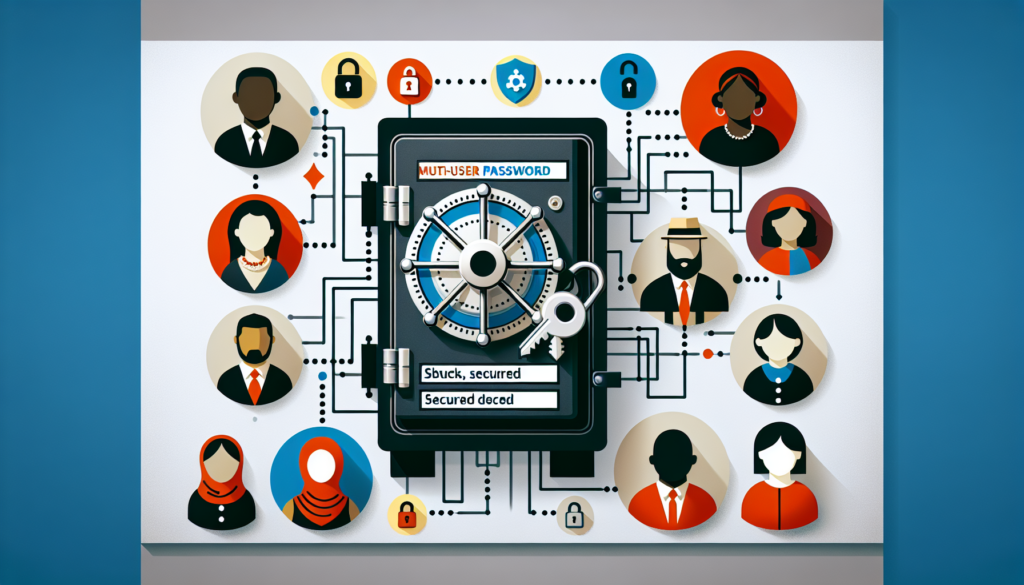Imagine the ease of coordinating sensitive login information across a team without compromising security. The Multi User Password Manager is your digital locksmith, creating a fortified and seamless environment where you and your colleagues can access shared accounts effortlessly. This tool is designed to enhance collaboration while ensuring that each password is stored securely, monitored for breaches, and is only accessible to authorized users. Say goodbye to the days of password fatigue and hello to a streamlined, safe way to manage your team’s credentials.
Understanding Multi-User Password Managers
Definition and Purpose
A Multi-User Password Manager is a tool designed to store and manage login credentials for multiple users within an organization. Its purpose is multifaceted: it aims to enhance security by creating unique, strong passwords for different accounts while also facilitating easy access to these passwords for authorized users. Think of it as a secure vault where all the keys to various digital doors are kept, with the ability to hand out copies of keys to those who need them under strict supervision.
How Multi-User Password Managers Work
At its core, a multi-user password manager operates on the principle of centralization. It centralizes all passwords in one encrypted database. When you need to access a website or application, the password manager inputs the credentials on your behalf. Because it’s multi-user, this system allows several individuals to use shared accounts without needing to know the actual passwords, all while maintaining individual accountability.
The Importance of Secure Password Sharing
In a collaborative environment, it can be tempting to share passwords directly with team members when they need access. However, this practice is risky and can lead to accidental or intentional misuse of credentials. Multi-user password managers allow secure sharing in which you control who has access to certain login details and track who used them and when. This ensures sensitive data remains secure while still facilitating teamwork and productivity.
Benefits of Multi-User Password Managers
Enhanced Security for Teams
A primary benefit of using a multi-user password manager is the heightened level of security it provides. These systems use encryption to protect your organization’s passwords, making them unreadable to anyone without authorized access. This significantly reduces the risk of data breaches due to compromised credentials.
Simplified Password Management for Multiple Users
Your team can save considerable time and effort with a multi-user password manager. There’s no need to remember complex passwords or waste time resetting forgotten ones. The password manager facilitates smooth and secure access for all users, letting them focus on their actual work rather than on managing login details.
Audit Trails and Accountability
These password managers often include features that track who accessed which accounts and when. This creates an audit trail that ensures accountability among team members. If something goes awry, you can easily trace actions back to the responsible party, allowing for quick resolution and prevention of similar incidents in the future.

Key Features to Look For
Secure Sharing Options
Look for a password manager that offers granular sharing controls. This way, you can determine precisely what information each team member can access and modify. Secure sharing should be straightforward and not compromise password strength or confidentiality.
User Management and Permissions
Effective user management features are crucial. You should be able to add, remove, or change the permissions of users as needed quickly. This flexibility helps manage the security of your organization’s data as your team changes and evolves.
Two-Factor Authentication
Two-factor authentication (2FA) adds an extra layer of security by requiring a second form of verification beyond just a password. This could be a code sent to a mobile device or generated by an authenticator app. 2FA is an essential feature for protecting your centralized password repository.
Compatibility with Multiple Platforms and Devices
Your team likely uses various devices and platforms. The right password manager should be compatible with different operating systems and have robust mobile apps to ensure you can access passwords from anywhere, at any time, securely.
Password Generation and Strength Assessment Tools
Look for a multi-user password manager that comes equipped with tools to generate strong, random passwords and assess the strength of existing ones. These features can greatly enhance your organization’s password security posture.
Setting Up a Multi-User Password Manager
Choosing the Right Password Manager
Selecting the right multi-user password manager is a crucial decision. Consider your organization’s specific needs, the size of your team, security requirements, and the compatibility of the software with your existing tools and workflows.
Creating a Master Account
Once you’ve chosen a password manager, the next step is setting up a master account. This account will typically set the security protocols and act as the administrator for your team’s passwords.
Adding and Managing Users
After creating the master account, you’ll add users to the system. At this phase, you establish their permissions based on their roles and what they need access to. Manage your users’ permissions carefully to maintain tight security while still providing necessary access.

Security Protocols and Best Practices
Regular Password Updates and Maintenance
Passwords should be changed regularly to minimize the risk of them being guessed or becoming stale. Your multi-user password manager should facilitate this maintenance with reminders and easy-to-use tools for changing and updating passwords as needed.
Educating Users on Secure Password Practices
Even the best tools can’t compensate for poor user practices. It’s important to educate your team on secure password practices to reinforce your technical safeguards. Train your users on how to spot and avoid phishing attempts, the importance of not reusing passwords, and how to handle confidential information.
Emergency Access and Recovery Plans
Prepare for the unexpected by setting up emergency access and recovery options in your password manager. In case someone who holds critical password information is unavailable, make sure there’s a predefined process in place for regaining access.
Compliance with Data Protection Regulations
With various regulations governing data protection, it’s vital that the password manager you choose complies with applicable laws and guidelines, such as the General Data Protection Regulation (GDPR) if you operate within the EU, or industry-specific regulations if they apply.
Integrations with Other Tools
Single Sign-On (SSO) Capabilities
Single sign-on enables users to access multiple applications with one set of login credentials. A password manager with SSO capabilities can streamline access across your tech stack, making it easier and faster for team members to get what they need.
Integration with Productivity and Communication Tools
A password manager that integrates well with the tools you already use – such as email, project management software, and communication platforms – can significantly boost your team’s efficiency and reduce friction in workflows.
API Access for Custom Integrations
Custom integrations may be necessary for specialized or proprietary systems. Look for a multi-user password manager that offers API access, allowing you to create a seamless ecosystem of all your tools and services.

Challenges and Considerations
Scalability Concerns
Choose a password manager that can grow with your business. Scaling up should be easy and should not involve a complete overhaul of your system or disruption to your team’s access to necessary accounts.
User Resistance and Training Requirements
Some users may resist changing how they manage their passwords, so it’s important to approach implementation with empathy and a solid training program. Helping users understand the benefits and guiding them through the transition can ease resistance and improve adoption rates.
Balancing Convenience and Security
It’s a delicate balance to strike – making password access convenient enough that it doesn’t hinder productivity, but secure enough to protect sensitive data. Ensure your chosen solution strikes the right balance for your organization’s needs.
Multi-User Password Manager for Specific Industries
Healthcare and HIPAA Compliance
In healthcare, where HIPAA compliance is mandatory, password managers must meet stringent security standards to protect patient data. Choose a service that offers the necessary encryption and access controls to comply with healthcare regulations.
Finance and Banking Security Needs
For finance and banking, where data breaches can have particularly devastating consequences, choose a password manager with robust security features and the ability to integrate with other financial security tools.
Educational Institutions and Student Data
Educational institutions manage a unique blend of employee and student data. A password manager used in such environments needs to be both user-friendly for less tech-savvy individuals and strong enough to protect the personal information of students.

Vendor Comparison and Reviews
Popular Multi-User Password Management Solutions
Several multi-user password management solutions are popular in the market. It’s worth researching and comparing these options to understand their features, pricing models, and how they might fit with your organization’s particular needs.
Key Differentiators Among Vendors
When comparing vendors, look for key differentiators like customer support quality, the frequency of security audits, and unique features that could benefit your team. These factors can make one option stand out over others for your specific context.
User Reviews and Feedback Analysis
Lastly, don’t underestimate the value of user reviews and feedback. Existing users can provide insights into the real-world application of password managers, their strengths, and their potential shortcomings. Weigh this information carefully to make an informed decision.
The Future of Multi-User Password Management
Innovative Technologies on the Horizon
Advancements in technology, like biometric authentication and artificial intelligence, are poised to revolutionize password management further. Keep an eye on these developments as they may offer new ways to manage and protect access to your organization’s data.
The Growing Need for Cybersecurity Measures
As cyber threats continue to evolve, the need for robust cybersecurity measures, including secure password management, becomes more pressing. A multi-user password manager is a critical component of a comprehensive cybersecurity strategy.
Predictions for Evolving Password Manager Features
Expect password managers to become more intuitive, predictive, and integrated with other security measures. Features like automated password updates and breach detection are likely to become standard, further streamlining and securing the login process across various platforms for multiple users.


